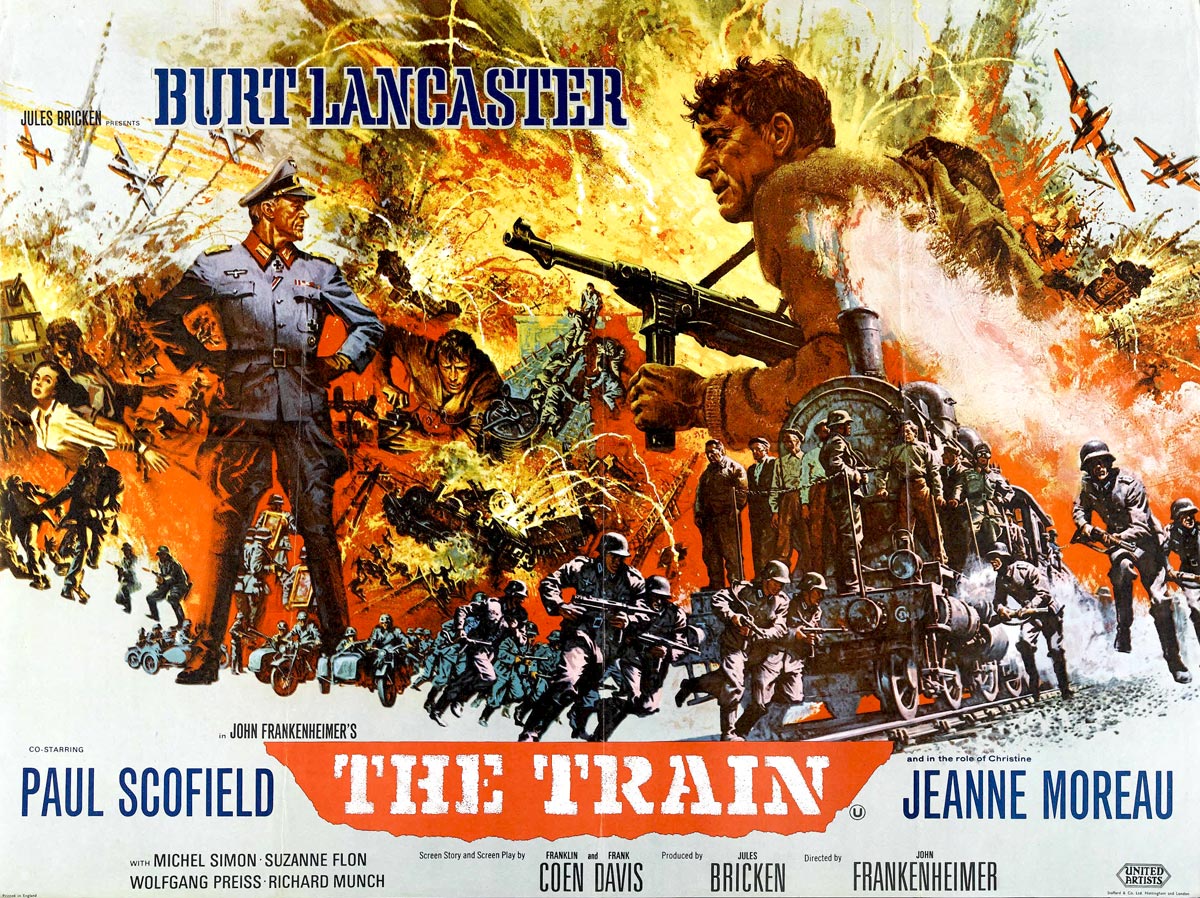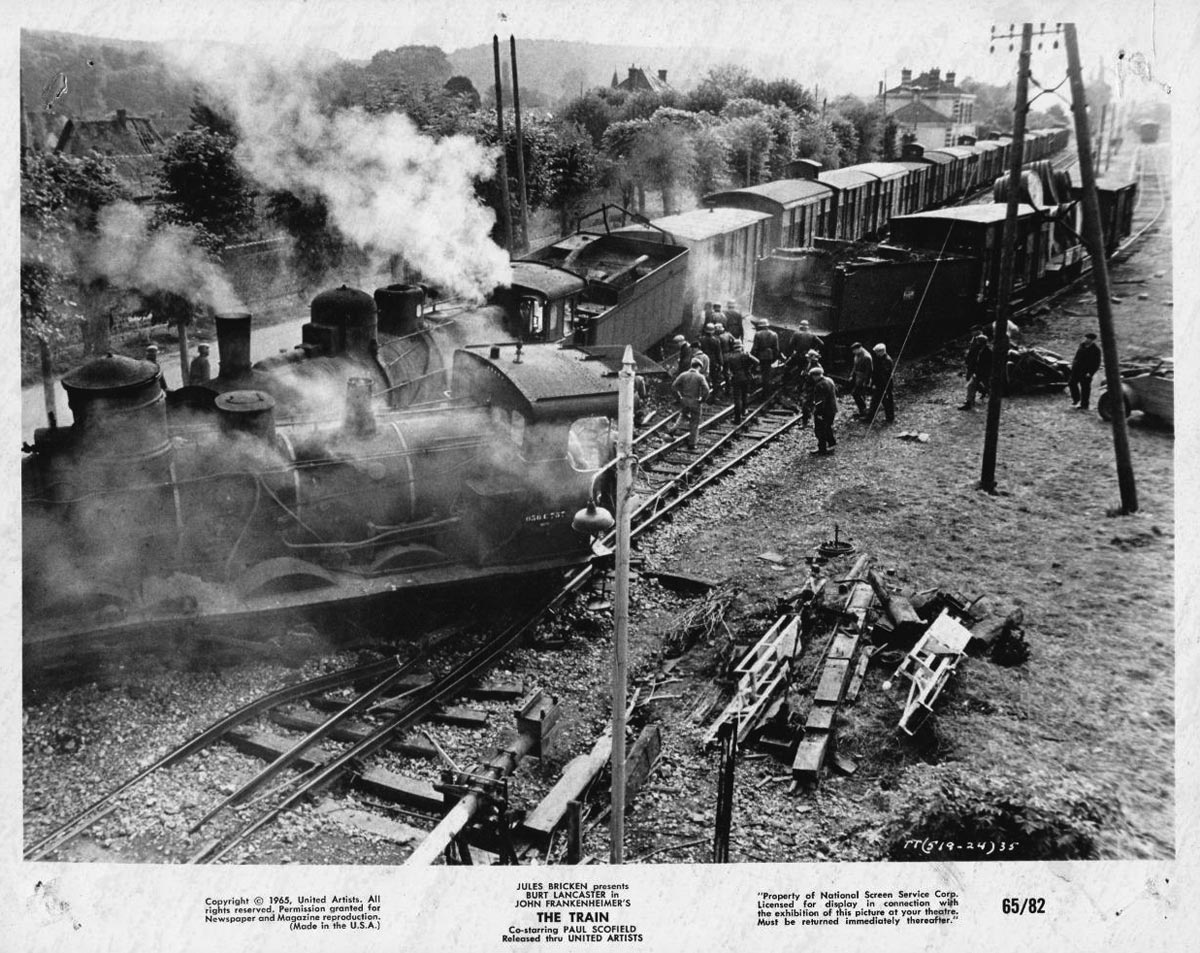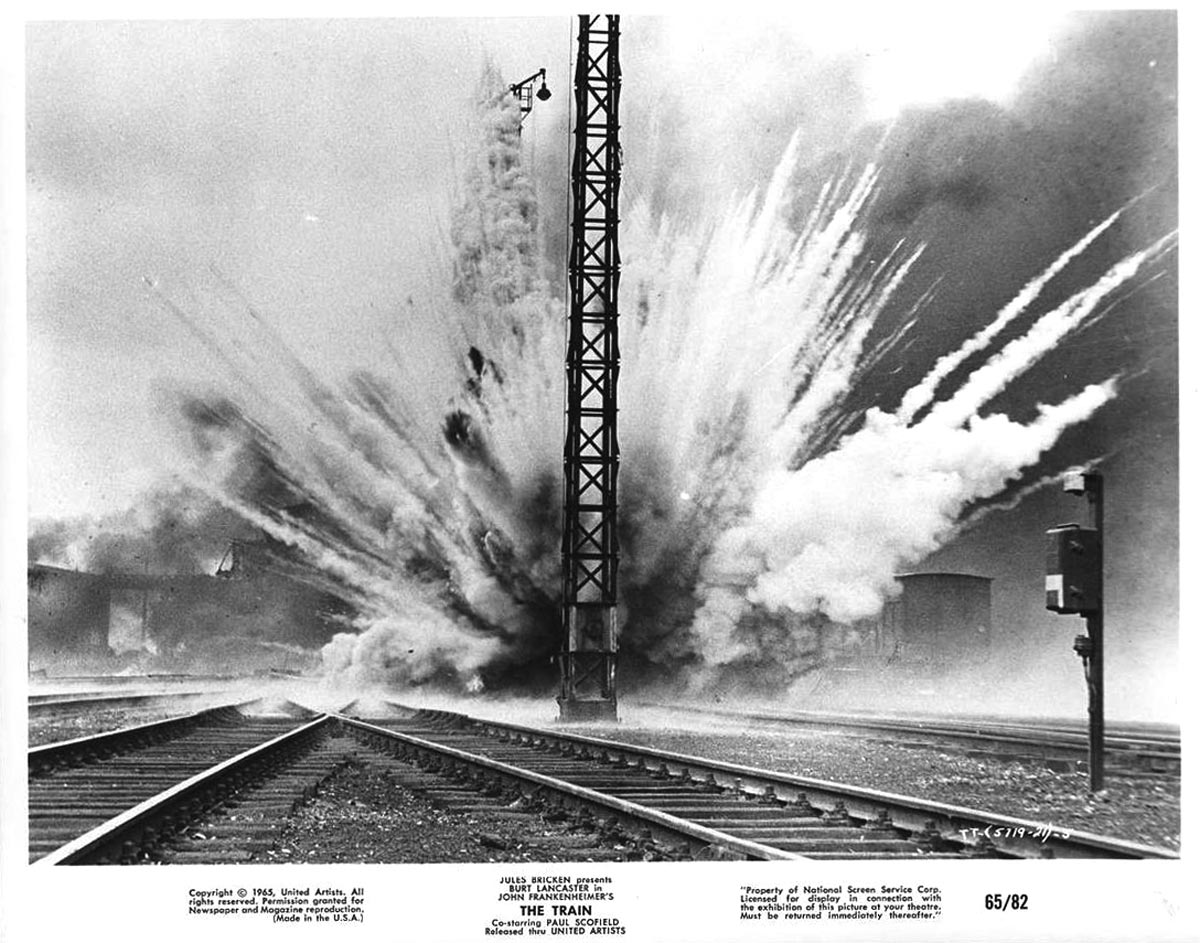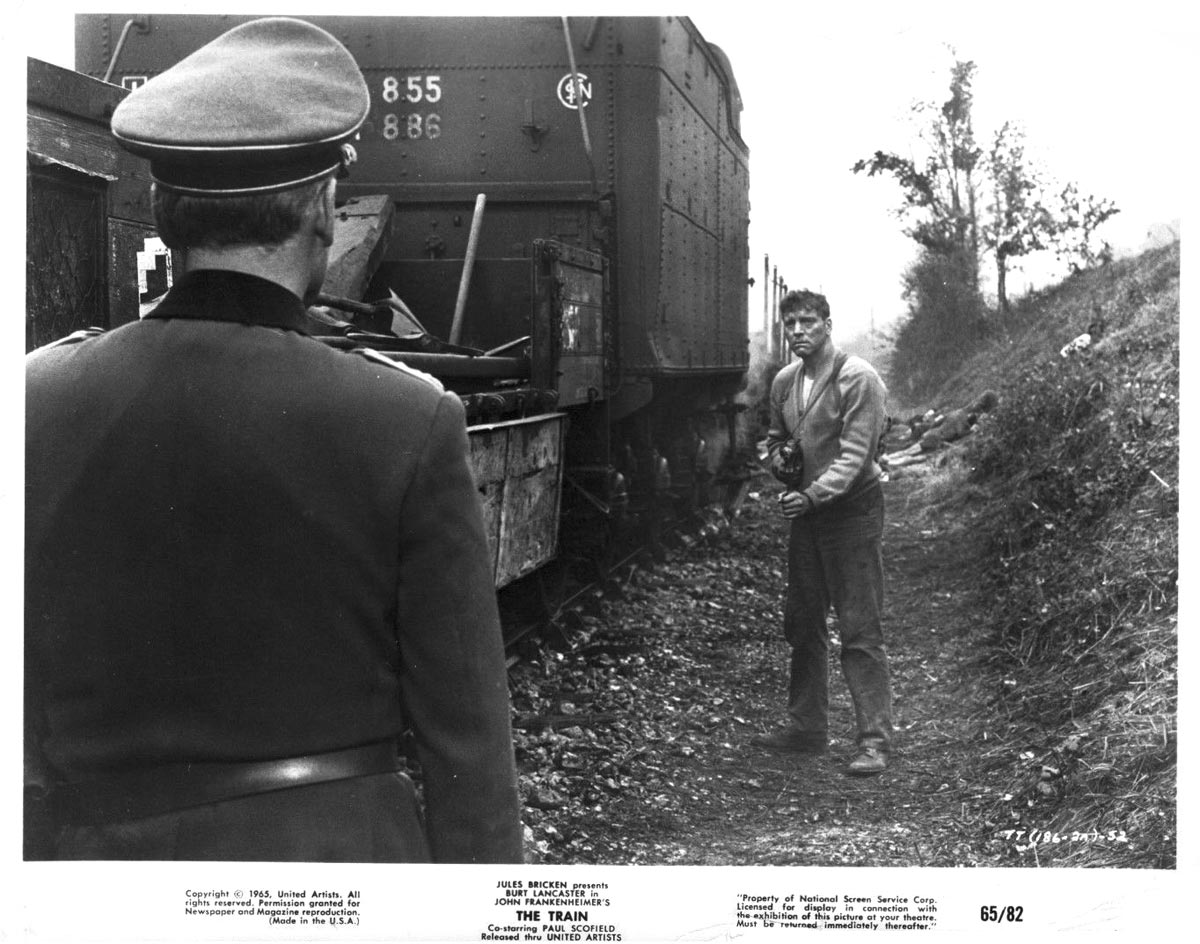Christine: Men are such fools. Men want to be heroes and their widows mourn.
Labiche: Perhaps men are fools. There were over a hundred involved in stopping that train. Switchmen, brakemen, yard gangs, stationmasters. God knows how many will be shot, like Jacques. You know what’s on that train? Paintings. That’s right, paintings. Art. The national heritage. The pride of France. Crazy, isn’t it?

The hero is not the first character we see and experience in John Frankenheimer’s The Train. We do not take in Burt Lancaster’s Resistance leader and SNCF railway superintendent, Paul Labiche, admiring famous works of art, those things he will, in brilliantly staged action sequences, risk his life to save from another’s possession and dispersion. Rather, we see Paul Scofield’s Nazi, Colonel Franz von Waldheim gazing, one might interpret, longingly, at the masterpieces. And we watch this all very quietly. It’s nearing the liberation of Paris – early August, 1944 – the 1,511th day of Occupation – and as the movie starts, a car drives up to Paris’s Jeu de Paume Museum with armed Nazis outside. From that driven car arrives von Waldheim, who then walks into the empty museum, removes his hat and coat and places them on the coat rack, as if he does this all the time. He surely does. This appears to be a sanctuary. You don’t see him smile, you don’t see much of his face right away, but by his slow, uniformed, leather, high-booted walk (there’s no score in this scene, just the sound of his boot heels and rubbing leather), you get the sense, immediately, that he has respect for this art based on his almost careful movements. He strides into a hallway, turns on a light, and gazes at the work, the camera finally fixing on his face in close-up as he admires or questions (one is not sure yet) a painting. Is he moved? His eyes are curious – for a second he looks near rapture, or maybe even sad, but then his eyes appear cagy, as if not to allow this emotion. We don’t feel for him, we feel wary and careful, a bit like he does, but for different reasons. We don’t want him to do something terrible in this vulnerable space. It’s a brief, rather brilliant moment and one in which another actor might reveal an overt poignancy or a sighing sort of worship. Not Scofield – he’s admiring and he’s hiding and he’s scheming and then he’s something else that’s too mysterious to define. He backs away from the work, slowly, and we start to understand that there’s reverence there, maybe even a certain type of fear mixed with devious power and selfishness.
The place is half dark with a light gleaming like a spotlight or, even more, like a divine beam on the masterwork – the place looks and feels like a black and white cathedral, and the stillness is eerily beautiful, but also nerve-racking. It’s just too quiet. As he continues walking backward, another light switches on and he turns, a bit startled. The film cuts to museum curator Mademoiselle Villard (Suzanne Flon) behind him, now walking towards his turned body. They know each other. They gaze at a Gaugin and she asks, “It was in the Clouvet Collection, wasn’t it?” He answers, “It was.” And then he asks, “Do you like it?” (As Murray Pomerance and R. Barton Palmer state in “A Little Solitaire: John Frankenheimer and American Film,” it’s “striking” the film doesn’t underscore that the art in the Jeu de Paume was looted from Jewish collections and that this scene naming the Clouvet Collection “is as far as The Train goes towards explicitly acknowledging the deportation and dispossession of France’s Jews.”) To her “liking” the collection, she answers rhetorically, “Need you ask?” The conversation continues:
Von Waldheim: As a loyal officer of the Third Reich, I should detest it. I’ve often wondered at the curious conceit that would attempt to determine tastes and ideas by decree.
Villard: Many times over the past four years I have wanted to thank you. For not being what you’d expected? For saving all this. Protecting it … I could have been sent away. Someone else brought in to be in charge of the museum. Perhaps I should thank you. I was foolish. I knew of books being burned. Other things. I was terrified that these would be lost.
Von Waldheim: A book is worth a few francs. We Germans can afford to destroy those. We all may not appreciate artistic merit, but cash value is another matter.
Villard: You won’t convince me that you’re cynical. I know what these paintings mean to you.
Von Waldheim: You are a perceptive woman.
She is perceptive. More than she knows and beyond what she knows (what do they really mean to him? And in what way?), because after this exchange, the art-loving, venal sophisticate declares the paintings to be seized and loaded on the train. He will take them, convince his superior of their value (despite their imagery as “degenerate”), and to Villard’s horror, attempt to transport the masterworks (including paintings by Renoir, Cezanne, Picasso, Braques, Degas, Matisse and many more) to Germany. Thus, begins a picture that gorgeously synthesizes precision, ingenious camerawork, richly toned beautiful black and white deep focus cinematography, exciting, unique action (from large scale explosions, to smaller, detailed moments), remarkable location shooting, history, performance, personality and art – the art within the film and the art of the filmmaking itself. And of course, those chugging, steaming, beautiful iron beasts – those trains – or, the train. They are works of art in and of themselves.

The question of saving art while risking too many lives faces off two incredibly willful men who enter this battle for very different reasons. We learn this when we finally meet our hero, or rather, our reluctant hero turned (as Brendan Gill said in The New Yorker) “contemporary Sisyphus,” Lancaster’s Labiche. Unlike von Waldheim, Labiche does not care about art and we presume he knows nothing about it (he values life more), so when Villard and Senior Resistance Leader Spinet (Paul Bonifas) press him for help, he’s not willing. He states, quite reasonably: “This morning we had four men left in this group. Now we are three. One, two, three… We started with 18. Like your paintings, mademoiselle, we couldn’t replace them. For certain things, we take the risk. But I won’t waste lives on paintings.”
His way of thinking changes when his father figure, the petulant, though lovable, older engineer ‘Papa’ Boule (Michel Simon) is killed – and with such casual disregard. In a masterful set of shots (there are so many in this picture), Frankenheimer (and cinematographers Jean Tournier and Walter Wottitz) show Boule carted away after he’s caught sabotaging the train with coins – slipping off the oil caps to reveal the franc pieces, tough-as-nails and maybe even crazy Boule states: “Four francs are four francs.” Boule has seen it all and will not kiss Nazi ass – he won’t even plead for mercy – but in a sublime close-up, he looks at Labiche with wearisome, sad eyes. He knows what’s coming. Labiche then pleads for mercy: “Colonel! He slowed up your train for a few hours but he saved it. He took it through the bombs at the risk of his own life. He’s an old man. He doesn’t know what he’s doing. I’ll get your train through for you. He’s just a foolish old man.” Papa Boule insists that the train is his (it’s a lovely moment, staking claim while insulting Labiche, whom he taught everything, which seems a code for I love you, goodbye, but, also, remember who I am…) and then spits at the Nazis. He is led away. The shot is now Labiche and von Wadlheim facing each other in symmetrical profiles, and Labiche further pleads for Boule’s life. As he begs, Boule is, in our vision and in the peripheral vision of Labiche, gunned down – dead.
It’s heartbreaking and so quick that Lancaster turns to look in the shot – there’s not cut or break here. Papa Boule is gone. When the camera does show Lancaster’s expression in close-up, it registers the loss and the malevolence of the act – his sooted-up face and sorrowful eyes looking on as the scene dissolves to fire – raging. It’s fascinating to learn that this scene was thought up so quickly. Simon had to wrap for another project so Frankenheimer had his character killed. It’s sad to see him go, but so effective because we love Papa Boule – it’s Michel Simon for heaven’s sake. And then, thinking of the real life and history of brilliant, singular Simon, who lived his own way, and with whatever social class or circle he liked; and who worked with, among so many greats, from Jean Vigo to Jean Renoir, just that face and lumbering body is a monument. When Papa Boule remarks earlier about Renoir (as in painter Pierre-Auguste and Jean Renoir’s father) whom he has little interest in, he says mischievously but rather beautifully, “I used to know a girl who modeled for Renoir. She smelled of paint.” Simon, the man, very well probably had known such a girl.

We’re past 45 minutes in the picture when Labiche really really finally decides to join up with his resistance compatriots – thought plenty of action has already occurred, including an entire train yard being blown up. No miniatures used, Frankenheimer was given permission to destroy the actual rail yard, which was set for demolition, and the resulting fantasia is a mesmerizing, almost Wagnerian thing of beauty. But when Labiche unleashes his unrelenting drive – when he engages in that Sisyphean struggle – to stop that train and with it, the determination of von Waldheim, the spectacle becomes a reflection of the dueling wills of Lancaster and Scofield’s characters: Lancaster outsmarting the Nazi navigators aboard the train by changing the names of the towns, the thrilling confrontation of machines – an airplane and a train (a scene that almost killed Frankenheimer), Scofield insisting on righting a full derailment with no resources or time left, a frontal collision between steam engines, and then the numerous times 51-year-old Lancaster sprints, jumps, dives, tumbles down hills, and outruns machine gun fire with acrobatic grace. It’s all so inventively beautiful, a thrill to watch, but artful at every turn, at times I was thinking of O. Winston Link’s large-format photographs of trains or of Rene Clement’s La Bataille du Rail or of Buster Keaton’s The General. But The Train, in style, substance and action, is entirely a John Frankenheimer movie, and one that offers no easy answers as it moves towards its uneasy conclusion.
Frankenheimer’s picture (his fourth of five with Lancaster – including The Young Savages and The Birdman of Alcatraz, Seven Days in May, The Gypsy Moths) was, remarkably, an assignment he took over after the original director Arthur Penn was let go due to differences with star and producer, Lancaster. It neither feels like a movie Frankenheimer took over nor a work for hire – it’s so intricately executed, so demanding an exercise, and at such a scale, that even with all the preparation and time in the world, an almost military precision would be needed to deliver. Frankenheimer and Lancaster worked together with such synchronicity, the actor’s movement, athleticism and physical presence, seamlessly blends with the director’s mobile camera – Frankenheimer’s tracking shots, his trademark wide angled compositions, his perfectly timed and dangerous action choreography in which Lancaster does all of his own stunts is an inspired union. It’s as if director and star are doing their own cinematic trapeze act – no nets. So flawless was their timing that without breaking pace, when Lancaster injured his knee (at of all places, a golf course during his leisure time) and worried that it would ruin the rest of the shoot, Frankenhimer proposed to feature a scene in which Labiche is shot in the leg, and proceeded to utilize his very real limp for the duration of the film. It’s a wonderfully affecting solution as watching Labiche, tired and haggard and literally limping to the finish line is as impressively strong as it is poignant and human.

Labiche endures and survives so much (indeed, he has little time to explore a connection with Jeanne Moreau’s sad, brave Christine) and the film’s final moments only allow him a slight reprieve. He’s worn out and sick of it all and, at times, it’s curious why he’s even still at it. Surely, it’s not the art. It’s life – his life to live, his country’s, and his need to prove the odds wrong, and yet, that’s not quite all of it. We don’t how to feel at the end of The Train – it does not end with a tidy, satisfactory conclusion – even when Labiche shoots von Waldheim dead. Frankenheimer chooses not to make the moment a cheering one, like many other pictures, but one of existential futility. In fact, the director believed von Walheim’s final moment was an act of suicide. The confrontation was created more on the spot by Lancaster and Frankenhimer as one version of the script (written by Franklin Coen, Frank Davis with the uncredited Walter Bernstein, Howard Dimsdale and Nedrick Young and very loosely based on “Le front de l’art” by Rose Valland) had a different, less powerful ending. According to Frankenheimer, it was Lancaster who suggested, “Why don’t we have him talk himself to death?”
He does. Facing off with Labiche, von Waldheim, the man who soaked in the paintings at the Jeu de Paume, fell in love with them, likely not just for monetary reasons but for his own, perhaps, selfish obsession with beauty now soaks in machine gun-wielding Labiche. He says:
“Here’s your prize, Labiche. Some of the greatest paintings in the world. Does it please you, Labiche? Do you feel a sense of excitement in just being near them? A painting means as much to you as a string of pearls to an ape. You won by sheer luck. You stopped me without knowing what you were doing, or why. You are nothing, Labiche. A lump of flesh. The paintings are mine. They always will be. Beauty belongs to the man who can appreciate it. They will always belong to me or to a man like me. Now, this minute, you couldn’t tell me why you did what you did.”
Labiche probably can’t entirely answer why. But that does not mean this malignant man is right in his obsessive, arrogant and selfish death speech, or that Labiche is a lump of flesh – he most certainly is not, who cares if he knows little of art. Labiche shoots him. That’s an answer. As Labiche leaves the scene of destruction – the sound and images working like a metronome of the steam punctuating the images of dead men and abandoned art – we wonder what he wonders or what he will wonder. He is alive. And, not knowing all the answers, he limps on down the road.


